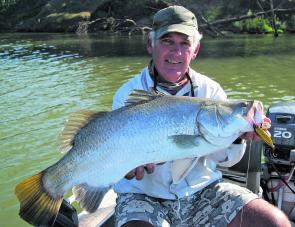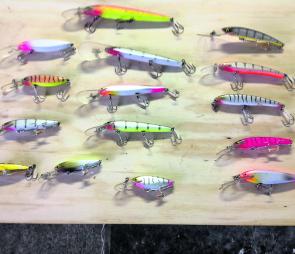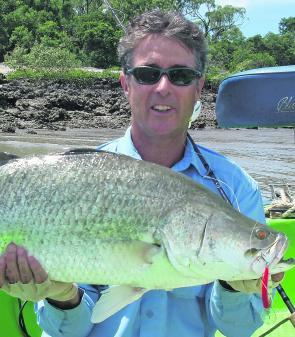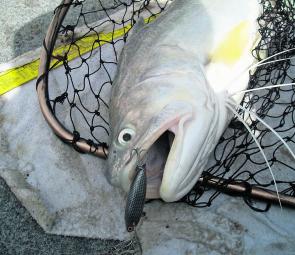Recreational lure fishing recently lost one of its few remaining timber lure shapers when Ken Richardson from Yeppoon lost his battle with cancer.
Ken, better known as Richo, was responsible for the brilliantly successful range of hand-made timber barra lures marketed as Richo Lures.
Richo was a strongly principled, yet humble man with an unshakable passion for timber lure shaping. I consider myself so much the richer and wiser for having had the opportunity to drop in unannounced to Richo’s backyard workshop and chew the fat about lure fishing techniques and theories on countless occasions over the years.
Every lure he produced was meticulously shaped, painted and field tested by his own hand before being deemed ready for the marketplace. Any lure with the slightest paint flaw would either be stripped and repainted, or relegated to Richo’s ‘seconds’ collection, which at times numbered enough lures to fill an entire tackle shop’s shelves.
If you’ve ever tried to make your own timber lures, you’ll appreciate how labour intensive and time consuming it is. Now imagine trying to make a living from manufacturing and selling hand-made timber lures. I reckon if you were ever game to work out the hourly rate you’d need to charge, you’d quit before even starting.
The challenge for any commercial timber lure maker is to compete pricewise with the endless range of injection moulded plastic lures on the market these days, not to mention just being physically able to build enough lures to satisfy the sort of orders tackle shops typically make.
Yet despite all the difficulties and temptations to go into mass production, Richo never succumbed to the pressure and continued producing his totally hand-made lures that Rod Harrison once rated among his Top 10 best barra lures. That was a huge rap for such a small time lure maker and something I know Richo was extremely proud of.
In contrast to how barra are typically targeted around Australia – by trolling or lure casting using an electric outboard – lure fishing in the Fitzroy River in Queensland has always tended to be by way of casting your lure from an anchored boat or from the bank.
When Richo moved to Central Queensland over 20 years ago, he started fishing for barra at anchor like everyone else was doing, but soon realised most of the lures being used had major shortcomings when being fished in this manner. Some didn’t dive down to their working depth quickly enough, while others were way too buoyant and wouldn’t swim properly at slow retrieve speeds.
Richo started experimenting with home-made timber lures and soon settled on a shape that was regularly catching barra for him. It was about 11cm long with a fairly large bib that enabled it to be quickly pulled down to its 3-4m working depth within half a dozen turns of the reel handle. That early prototype became the basis for the now legendary Extractor 11.
Richo refined his casting at anchor technique over time and openly shared his ‘secrets’ with his friends and fishing partners – fortunately I was one of those lucky people. His technique isn’t based on rocket science, but rather based on barra preferences and behaviour. It recognises that barra are essentially lazy fish, that tend to ambush their prey from a strategic position, as opposed to fish that are actively out swimming about hunting down a feed. That of course means you should be looking for barra hiding under a large snag, at the mouth of a gutter, or in the quiet water of a tidal eddy created by a rock bar.
The ambush point is often a few metres below the surface, so unless your lure passes within a metre or so of the barra’s hideout, it’s unlikely it will decide to attack your fake fish.
Now while random trolling for barra is effective for catching barra and is the preferred method in the Northern Territory rivers, it just doesn’t require the same level of angler skill and knowledge that lure casting at anchor does. And there’s nothing quite like the adrenalin rush associated with a barra strike initiated by you after calculating where the fish is likely to be holding and presenting the lure perfectly.
The key element of Richo’s lure casting technique is the ‘pause’. He never claimed to have invented it, but he did perfect it.
I now use the pause retrieve as my default barra lure casting technique and my lure of choice is always a Richo, because being timber, when you pause them, they don’t immediately pop straight back to the surface like so many plastic hardbodies do, but slowly and steadily begin to rise during the pause, staying in the strike zone for longer. After a second’s pause, a rip or twitch will pull the lure back down to its optimal depth where the barra are hanging and you can pause it again almost straight away. I find more often than not, the barra slams the lure during the second or even third pause of the retrieve.
Richo developed a range of shapes over the years, many of which never saw a tackle store shelf. This wasn’t because they didn’t work, but generally because Richo felt he couldn’t guarantee that every lure of that particular style would ‘swim’ the same, therefore he wasn’t willing to take it to market unless he felt it was perfect.
His close friends were the beneficiaries however, because he’d give the select few some of his prototypes and not quite prefect shapes to field test.
As an example, I was using and catching heaps of fish on what ended up being the Richo Herring for about three years before he finally decided it was good enough to go on sale to the public. The Richo Herring remains my go-to lure when nothing else seems to be working and it rarely lets me down. Unfortunately I only have three Richo Herrings left, none of which are anywhere near to pristine condition, so I’ve decided to continue using them in Richo’s memory for as long as they last.
A few months ago, Richo told me he’d had a few fairly serious offers for his shape patent, but I’m not sure if he managed to come to a commercial agreement in this regard. Hopefully his family will sell his shapes, but it would be more than likely in that event that the result would be plastic versions appearing on the shelves rather than the famous timber hand-made Richo legends.
The lure fishing community is so much the richer for Richo’s contribution and wherever he is now, I’m sure there will be a few barra there for him to chase.
Reads: 5258
Bill Bowtell with a Richo’s-caught barra.

Richo made a large range of lures, some of which never sold commercially. Ken made prototypes for friends after discussing a certain style of fishing or even a particular area and depth of water with them.

The author caught this great barra with one of his favourite go-to lures – the Richo Herring.

Every lure Richo produced was meticulously shaped, painted and field tested by his own hand before he deemed ready for the marketplace.

Richo with one of his favourite things to catch – a cracking mangrove jack!




